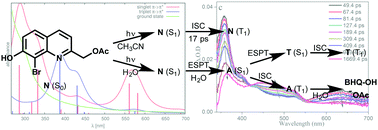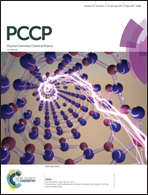Unravelling the early photochemical behavior of (8-substituted-7-hydroxyquinolinyl)methyl acetates through electronic structure theory and ultrafast transient absorption spectroscopy†
Abstract
The photophysical processes and photochemical reactions in the ultrafast time region of (8-bromo-7-hydroxyquinolin-2-yl)methyl acetate (BHQ-OAc) in acetonitrile and neutral aqueous solutions were investigated using quantum chemical calculations and femtosecond transient absorption spectroscopy. After initial excitation into the π,π* excited state, BHQ-OAc undergoes an ultrafast intersystem crossing (ISC) into a π,π* excited triplet state on a timescale of 16 ps. The n,π* and π,π* excited singlet and triplet states involved in the photochemistry were identified by means of their characteristic excited state absorption (ESA) bands and from second order coupled-cluster (CC2) calculations. The high ISC rate of BHQ-OAc and related compounds is traced back to involvement of almost energetically degenerate n,π* excited states that enable efficient ISC that obeys El-Sayed's rules.



 Please wait while we load your content...
Please wait while we load your content...